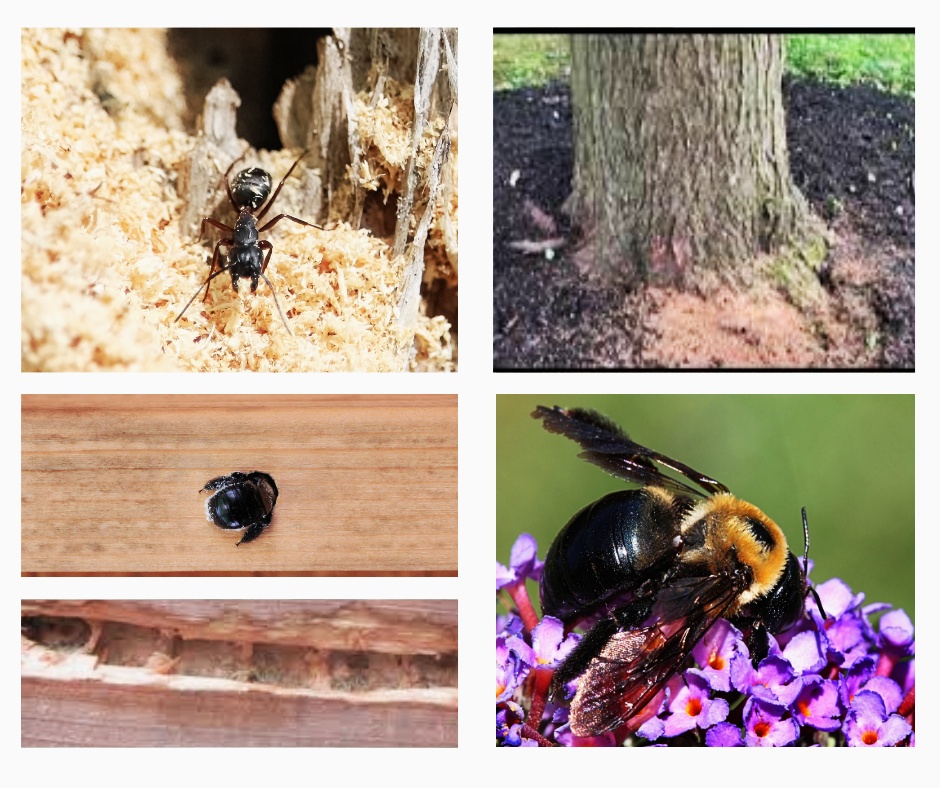Rainy Days for these Carpenters can mean saying goodbye to wood in homes

Ah, the ‘70s, the time of my (and maybe your) youth. I loved The Carpenters, the duo. But there is another duo of carpenters I get asked about every year, and it is not those longing for the artists. They are the skilled union trades; no, not them, either. It is the insects! Carpenter bees and carpenter ants.
These two insects are far less harmful than you might think. But their signs make many gardeners and homeowners panic. For the carpenter ant, it is seeing a large pile of sawdust at the base of a tree. And with the carpenter bee, it looks like a child got their hands on a cordless drill on any unfinished wood surface (often your deck or fascia); they make perfectly round, dime-sized holes.
So what are we to do? Little to nothing. Or something. It depends. Carpenter ants are identified by the little yellow hard hats and tool belts they wear. Just kidding. But they are very large, shiny black ants that are over a half-inch in length. No hat, no tool belt.
Carpenter ants, when found in trees, are actually helping you keep your trees longer. Just like we age, trees do, too. And the center of mature trees naturally starts to rot. Many people are shocked when they see a giant shade tree toppled over by a storm, and the inside is empty, but the tree was in perfect healthy leaf.
The reason is, the living part of the tree is just under the bark. They center wood, or heartwood, is just accumulated dead wood of the circulatory system that acts as support. Carpenter ants smell rotting wood (inside our out) and use the rotting area to build their homes, called galleries.
Carpenter ants do not structurally damage trees like termites can. Carpenter ants chew out the rot and spit it outside of their new home—that is why you see the shocking pile of sawdust at the base of your tree. Carpenter ants actually slow the rot by cleaning it out.
Trees that have carpenter ants should be inspected by a tree professional periodically. They will do a core sample to see how much of the tree trunk is left, to be sure there is enough to support the weight of the canopy. Killing the ants is not necessary or recommended.
Now inside the home is a different story. Again though, no need to panic. Carpenter ants again are attracted to rotting wood. Countless times, I have people tell me that the “spray” must not be effective on killing carpenter ants, because after treatment, it won’t be long that more will appear.
That is because you didn’t get to “the root” of the problem (how I love a good garden pun!). You must find and replace the rotting wood in your home, and then future carpenter ants are not interested in your home. The two most common issues for wood rot in the home are from an ice dam that formed in your gutter and the water backed up and rotted wood. The other common site of wet, rotting wood in the home is a leak from a pipe behind a wall, like a toilet connection.
Sprays do nothing, other than kill the current group of carpenter ants; your home will still have an “open” restaurant sign that attracts more of them, until the wood rot is completely eliminated. Even with the rotted wood, carpenter ants are not structural pests like termites. Think of them as tiny little home inspectors warning you of the problem.
Carpenter bees are also misunderstood. Carpenter bees look like our native bumblebee –you know, the black-yellow-black pom-pom bee. But carpenter ants have a shiny, hard abdomen instead of the pom-pom fuzzball.
Carpenter bees are solitary bees that do not make a collective hive. The females make perfectly round, dime-sized holes that they excavate for their nests. In this constructed tube, she will lay an egg, grab some spring-flower pollen, and put it with the egg like a sack lunch. Then she will wall off that cell with some chewed wood pulp she gathered and then start the process again.
She prefers soft, unfinished wood to set up her home. Painted surfaces are usually left untouched. Unlike carpenter ants, repeated infestations of carpenter could cause structural damage, but again, not like termites. Termites actually eat wood, carpenter bees and ants, chew up wood and spit it out.
The biggest reason people fear carpenter bees is their size, speed and territoriality. The females could sting, but are not interested in you. They would only sting predators to their nests. The boys, however, are very territorial; they will swoop you like a World War II dive bomber. But they are all buzz and no action — they don’t even have a stinger.
Before you decide on controlling them, realize these bumblebee look-alikes are excellent pollinators. Their size and hairiness make them pollen magnets. They are definitely part of the beneficial insect group. But just like us, we all have some positive and some negative in us.
If you decide you need to control carpenter bees, you can start with prevention by painting and sealing wood surfaces. Prevention is always better than treatment when it is an option. But what if you already have some holes? You can stop the situation from continuing with exclusion techniques, such as stapling some window screen replacement over the area after you caulk the existing holes.
For chemical options, you can use anything with the one of these active ingredients bifenthrin, cyfluthrin, deltamethrin or lambda cyhalothrin.
